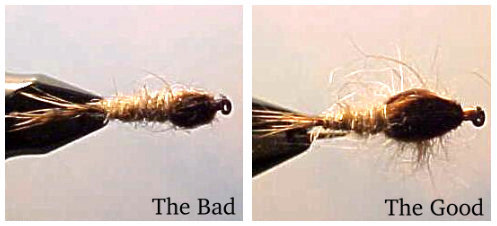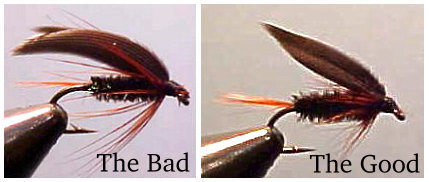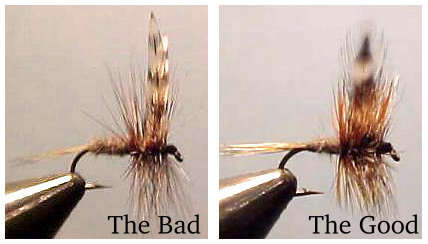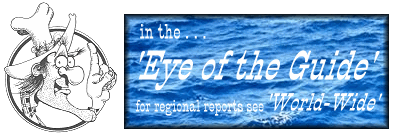The month of May is upon us, and in the Northeast, this is the time
of peak hatch activity and fly sales. Flies are no longer a throwaway
item, and, with prices ranging from $1.50 to $2.00 per copy and up, I'm
often amazed that fly buyers will grab the first fly that comes to hand
out of a bin full, without even looking at their purchase. It seems that
most fly purchasers will ponder the right pattern to buy ad nauseum and
then pick any old fly that seems to meet their needs, no matter how
poorly tied.
The purpose of this article is to inform fly purchasers of what to look for
in a well-tied imitation. With the hundreds or perhaps thousands of fly styles
extent, it is impossible to examine all of them in a relatively brief web article.
I have selected three relatively common fly types- a nymph, a wet fly, and a
standard dry fly - for an in depth look at fly quality. Hopefully, the lessons
learned from these flies can be applied to other fly types as well.
The topic for this article was the product of a late night email conversation
with Jim Kelly, who designs and executes the FFP website. Rene Harrop,
the noted Idaho tyer, wrote a piece along the same lines for one of the
Scientific Anglers flyfishing annuals nearly a decade ago.
Nymphs

The pattern I've selected for comparative purposes is the Gold-Ribbed
Hare's Ear Nymph, one of the most popular subsurface flies used in the
United States. When anglers are asked to select their top ten flies, chances
are a GRHE will be among them. Taking just a cursory look at the two
flies pictured, it's easy to see that the well executed pattern is on the right.
It has a pleasing taper and overall symmetry not found in the clunky,
substandard tie to the left. Let's take a more detailed look at the bad
fly Vs the good fly.
The tail on the poorly tied imitation is thick and overly long. Natural nymphs
have two or three tails. A few extra fibers are fine, but a solid mass of
several dozen fibers is inappropriate. Long tails are almost an extension
of the body and produce a fly that appears too big. Tails of 4-6 fibers
approximately one-half the shank length appear proper.
The abdomen of a nymph should extend over about one-half the length
of the shank and have a pleasing taper, growing toward the thorax of the
imitation. The nymph on the left demonstrates too long an abdomen and
a poor attempt at tapering, in contrast to the properly tied fly. Bad tapers
are not just an appearance issue. Lumpy, bumpy bodies are more easily
destroyed by trout teeth.
The thorax of a nymph should comprise approximately the forward half
of the fly. It is a robust area of the natural, from which the nascent wings
will emerge. The nymph on the left reflects a skinny, short thorax, typical
of a badly tied imitation, while the fly on the right has proper proportions.
The well-tied fly has a neat tapered head, while the head on the bad fly
crowds and partially closes the hook eye.
One final comment on this pattern seems in order. Part of the effectiveness
of the GRHE nymph depends on shagginess, accomplished by picking
out the dubbing to suggest legs and gills. The well-tied fly has been fuzzed
out nicely, while the tyer of the poor fly neglected to do this final and crucial
step.
Wet Flies

Although soft hackled wet flies have a small, but vocal, following due to
the efforts of Sylvester Nemes, wet flies are probably the most neglected
of all fly types in modern flyfishing. They do not suit every fishing situation,
but nonetheless wet flies deserve more use than they get, and they are still one of the
easiest of all flies for beginners to use. The wet fly presented for analysis
is the Leadwing Coachman, a vintage pattern that is useful during both
Grannom Caddis and Slate Drake activity. Classicists will recognize that
the pattern presented is different from the normal Leadwing Coachman in
that I omit the gold tag and add a tail.
As with the nymphs the well-tied fly is on the right, and the badly fashioned
fly is on the left. Beginning with the tail, the poor model has a tail slightly
shorter than the shank length accepted as a proper proportion. The body
on both flies is similar, but a careful examination of the photo will reveal
that there is bare thread showing behind the body of the badly tied fly,
a mistake common to starting tyers.
Standard wet flies should feature hackle 1.5-2 times the gap of the hook
in fiber length. Clearly, the hackle on the fly on the left is too long, reaching
past the bend of the hook. Once again, the fly on the right reflects proper
hackle sizing, in that the tips of the hackle extend to the point of the hook.
Finally, the wings on the poorly tied wet are very long, stretching well past
the hook bend. The good example of wet fly style also shows appropriate
wing curvature. The natural curve of the wings points upward, and this
method of wing attachment allows the wings to move well in the water,
giving the trout extra incentive to eat the fly. When a wet fly is tied with
the natural quill curvature downward, the wing is listless and immobile.
Standard Dry Flies

The Adams, selected as a standard dry fly for this analysis, is clearly one
of the most popular flies in use. Although some of its glitter has been taken
away by offshoots like the Adams Parachute, the standard Adams is still a
fine choice for all but the most critical hatchmatching situations. Its bugginess,
based on its mottled coloration, has tempted trout since its creation in 1922,
and a standard dry fly, unlike flush floaters like comparaduns and parachutes,
resists drag extremely well.
We'll begin our analysis with the wing, the first step in tying this fly style.
The improper Adams, once again on the left, displays an overly long wing,
a fault that usually causes the fly to land on its head. A well-tied Adams
should have a wing equal in length to the shank of the hook, sizing aptly
shown in the fly on the right. Moreover, the badly tied Adams has a wing
fashioned from wispy cock hackle points. These will slim down when
fished and show a poor silhouette to the fish. The well-tied Adams has a wing of
fairly wide hen hackle tips, which retain a more visible profile for both the
trout and the trout fisher.
Proceeding to the tail, the second tying step in a standard dry fly, the fly
on the right shows classic proportioning, in which the tail is equal in length
to the shank of the hook, extends straight from the shank, and contains
enough stiff fibers to support the fly. The poorly made Adams has a wimpy,
sparse tail. If this fly does not fall on its head when cast because of its
over-long wings, it will surely sink butt first because of its skimpy tail.
The body on the bad Adams is lumpy and bumpy and extends slightly
down the bend of the hook, a sure sign that the tyer was too much in a
hurry. The fly on the right shows a tight, well-tapered body. This is not
merely a question of aesthetics. The first time a sharp trout tooth nicks
the body of the Adams on the left, it is apt to shred and unravel, rendering
the fly useless.
The final step in dressing a standard dry fly is applying the hackle. There
is a marked difference between the two flies. Proper hackle sizing for a
standard dry is 1.5-2 times the gap of the hook, proportioning
demonstrated nicely by the well-tied Adams. The fly on the left has
overly long hackle (2.5-3 times the gap in fiber length). The hackle is
not only too long, but it has been poorly wound, with fibers askew. The
fly on the right shows compact, dense hackling, sure to float the fly well.
Summary
The purpose of this article has been to inform fly purchasers of what to
look for in a well-tied imitation. Although the ability to judge fly quality
critically really comes only after long hours spent at the tying vise
yourself, even a beginning flyfisher should have some notion of proper
fly proportion, of the materials used to tie a good fly, and of the overall
symmetry a properly made fly should have. A well-formed, neat,
tapered head, allowing easy attachment to a leader, is a benchmark
every good fly possesses. By spending a little more time at the fly
bin and making the right choices, fly buyers will be able to spend
their hard earned dollars more wisely on flies that fish better and
last longer. ~ Steve Sywensky
©Flyfisher's Paradise-2000
|




